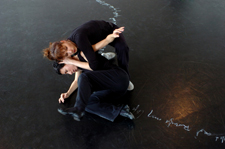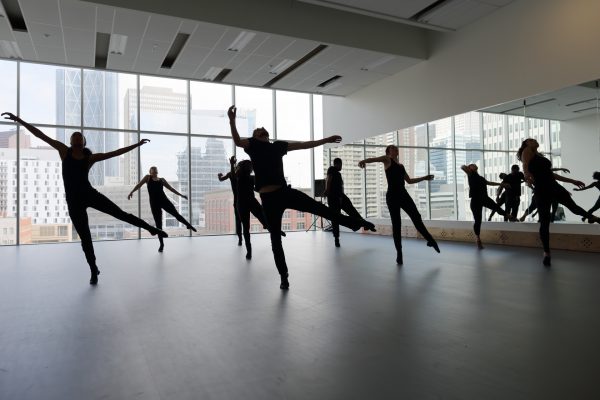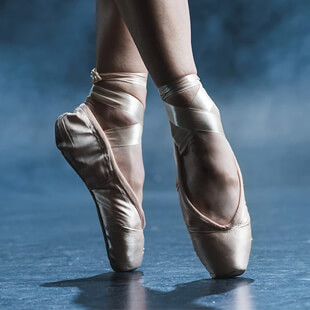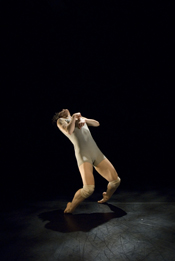It is week three of Blackbox and I’m aggressively rubbing mushed banana over my face and neck. Draping the peels over my arm, I then spike them to the wall behind an audience of wary onlookers and sing Amazing Grace to the banana corpses.
If someone had told me three years ago this is what dance school looks like, I would have laughed in disbelief. Yet since beginning my BFA in contemporary dance at Simon Fraser University, this is the first time I feel I am unlocking my creative potential. Who knew that bananas and thumbtacks were the key?
‘Blackbox’, or FPA 353 as it is officially called, is a devised theatre course and one of the most demanding programs offered by SFU’s School of the Contemporary Arts. Every two weeks we put up a show. Although technically the class runs twice a week, we are soon rehearsing from 6-10pm on weeknights and 10am-6pm on weekends. Say goodbye to home-cooked meals, eight hours of sleep and friends outside of school!
Devised theatre is a collaborative process. The content arises from the creators. Even the directors come from our cohort: students who have expressed interest in exploring a topic. Unlike typical directors, they draw their material and inspiration from their collaborators who create work based on that topic. Cole Lewis, the professor overseeing Blackbox this semester, says her desire to open the course up to dancers arose from “a dissatisfaction with my own process of devising. I wanted to use the course to look at different forms, to truly explore what interdisciplinary means.”
In my audition for the course I am given a list of seemingly impossible demands: “Your piece must be 4 minutes and 44 seconds long, include water, a brutal gesture and an accident” among other stipulations. For a dancer, the task is nerve-wracking. I am being assessed on something distinctly more intangible than physical ability. As dancers, we constantly meet challenging demands; our bodies can do what most cannot. Yet, it is not just the movement but also the artistry behind it that makes all the difference. Artistry is much harder to teach than pliés and tendus, but Blackbox aims to do just that. By the end, I hope I have become a better artist.
On the first day of class, I observe actors warming up. People are running around the room; some are screaming. It looks like an elementary school playground at recess. Compared to the quiet calm of dancers stretching at a barre, my initial impression confirms my assumption that dance and theatre are drastically different disciplines. Soon, though, I’m right in there with them. Blackbox operates under the ethos of exquisite pressure. In short amounts of time and with limited resources we are expected to always make our best work. At first this feels challenging but I come to love the high stakes. A typical rehearsal has us making compositions in twenty minutes, stringing those compositions together and crafting something weird and wonderful. However, as I soon find out, there is an art to play.
Robert Azvaredo, a graduate of the SFU dance program, was the first dancer to participate in a Blackbox course. He’s well aware of having paved the way for others. Although SFU prides itself on interdisciplinary programming, the school struggles against a design that keeps students segregated. Theatre and dance have the benefit of being on the same floor, yet they each have separate eating areas. But for Robert, theatre students were “just down the hall”. Why not “go knock and see what they’re up to?”
Dancers need incentive to try something outside of their already busy schedules and walk down that hall. Lewis says that in this course dancers have the opportunity to “explore different relationships to space and story and body through action.” For my part, I’ve always been interested in the creative process. I consider myself an aspiring choreographer as much as a contemporary dancer.
What you get from the experience, one focused on “the process versus the product” (Azvaredo), is the opportunity to experiment. If anything, Blackbox gives you the tools to play. Dancers, generally speaking, have a hard time with this. We have been taught our whole lives to follow, not lead. We practice for hours to learn choreography so that it looks just right, unlike theatre students, who generally understand “rules are meant to be broken” (Azvaredo).
Throughout the semester, Lewis introduces us to the concept of the ‘Toolbox’, essentially parameters we can choose to use to make better work. Some of my favourites include: a revelation of space — one classmate built a house around the audience using wooden pallets with plastic screens; an unexpected sound source — an ipod hidden in a piano; a moment of transcendent grace or beauty — humans in embryo-like bags rolling through a space. These and many other strategies are highly applicable to creating dance work, and, I believe, have the potential to make dance more engaging.
However, the arts community exists within an economic system that sees monetary gain as the only marker of success. Play, with no specific product in mind, is inherently threatening to this model. Yet artists know that play births creativity. Increasingly, choreographers are not as interested in cookie-cutter molds. They want dancers who can offer interesting movement choices, have presence and clarity of vision.
As I write this, Blackbox is nearing its end. We have two more weeks to create our last show and then our group will disband. I wonder how I’m going to feel. After being so busy for so long, I feel like I have forgotten how to relax. If anything Blackbox has shown me that I am capable of really hard work! Although I am looking forward to escaping to a forest to sit with the trees, I am equally looking forward to coming back to this city and making more art. Just as waves merge with the sky at the horizon, in my mind the line between dance and theatre has become blurred, the distinction between the two no longer that important.





